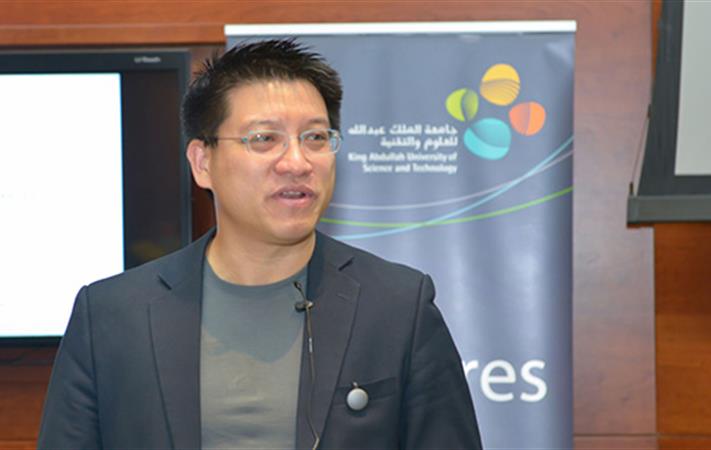Technology and design bring on the Wearable Revolution

Sonny Vu, CEO of Misfit Wearables
“If you’re going to be in the consumer space, sell the product and then make it. Not the other way around. It may sound like a crazy way of doing things, but there are mechanisms that allow you to do this these days,” said Sonny Vu, a Silicon Valley entrepreneur and CEO of Misfit Wearables, last month at KAUST. As part of New Ventures’ Entrepreneurship Speaker Series, Vu gave a talk on the central role of design in our technology-driven global economy.
Sonny Vu’s philosophy and approach to start-up product launches mirror the training pillars of KAUST’s own Entrepreneurship Center, which teaches emerging entrepreneurs to validate their product ideas directly with the customers before launching a business. Referring to the book The Lean Startup, Vu believes in rapidly prototyping a new product idea and in “being relentlessly focused on getting user feedback and minimizing the cost of experimentations in order to be able to learn cheaper and faster."
Crowdfunding and the Wearable Space
“The approach of build it and they will come is not a very smart way of doing things,” Vu argues. He also suggests that any new product “must be an enjoyable user experience that will make the customer want to come back again and again to the whole experience.”
This philosophy was behind the success of Vu’s previous company, AgaMatrix. The groundbreaking product, launched in 2010, was a self-powered glucose meter. It was the world’s first iPhone-connected hardware medical device, which diabetic users could easily carry along with them.
Following the commercial success of this product, Vu’s belief was reinforced that the growing wearable space was the way to go for his next company.
“The advent of mobile Internet has redefined how data sensors are used. The big move that we’ve seen in recent years has been in ambient sensing,” he explained. Much of the current traction and consumer interest in the ambient sensor technology space is in the fitness, health and wellness areas. Those trends informed his decision to create a wearable activity monitor, the Shine.
Unlike many of his competition’s activity monitor devices which are made out of plastic, the Shine was designed to be stylish and simple enough to be worn by the users on their wrists or chest to go anywhere. When you think about it, he says, “Who would want to wear plastic?” The elegant device he created is a small dish-shaped metal activity monitor. It does not require charging, has no wires, and requires no syncing cables. It’s also waterproof to 50 meters, which makes it popular with swimmers.
His new company, Misfit Wearables, did not initially go through the traditional venture capital funding route. They instead opted to raise their $100,000 funding goal through online crowdfunding. Interestingly, within nine and a half hours, they had met their fundraising goal. This was accomplished with just a YouTube video embedded on their crowdfunding page and without a PR firm or marketing budget. “Immediately, I thought this is a product that people are going to want,” Sonny Vu said.
A Customer-Focused Approach to Design
As was the case for the iPhone-connected glucose monitor, the rollout of the Shine activity monitor was very much design-oriented. And, as Vu theorizes, the best way to devise a design strategy for any product is to observe people’s behavior.
By designing an easily portable medical device connecting to the iPhone, Vu’s previous company responded to the observable fact that many diabetics didn’t test enough because they left their glucose meters at home. However, these same people would rarely forget their iPhone. A physical connection to a device ensures that the user has it with them all the time. “So we saw glucose testing rates skyrocket,” said Vu once his product allowed diabetic users to turn their iPhone into a glucose meter. So design, informed by customer behavior, was able to transform an entire industry.
The Role and the Future of Data
We’ve come through the era of the PCs in the ‘80s, the Internet in the ‘90s, and mobile and the social revolution in the 2000s. The big discussion right now in Silicon Valley and elsewhere in the world, as Sonny Vu posits, is around data. “We now have the unprecedented opportunity to collect an enormous amount of data about ourselves and about people in general,” he adds. Moreover, that data is readily sharable.
So in addition to design, Sonny Vu determined that, in order for his company to stay relevant in an increasingly crowded space, he needed to focus on “making it about having better data.” The more an activity monitor, such as the Shine, can be viewed by the user as “beautify and invisible,” the more they will instinctively keep using it.
Once such a device is adopted long-term and is able to collect a year’s worth of uninterrupted data for instance, much valuable information can be gleaned. For example, a user can determine that they don’t sleep enough on Thursday nights. Additionally, the data can show the resulting long-term effects if the user continues on that same path.
“Our objective has always been to make great wearable products; things that are worn all the time by a lot of people for a long time,” said Vu. After that information has been collected, “it’s about making the data very useful,” he concludes.
The Entrepreneurship Center participants have received private mentoring sessions with Sonny Vu to Asses their VentureLab projects and provided them some valuable market insights. The center is always seeking to attract the entrepreneurial talents that will motivate and inspire the start up ideas and guide them to the road of success.
- by Meres J. Weche, KAUST News

